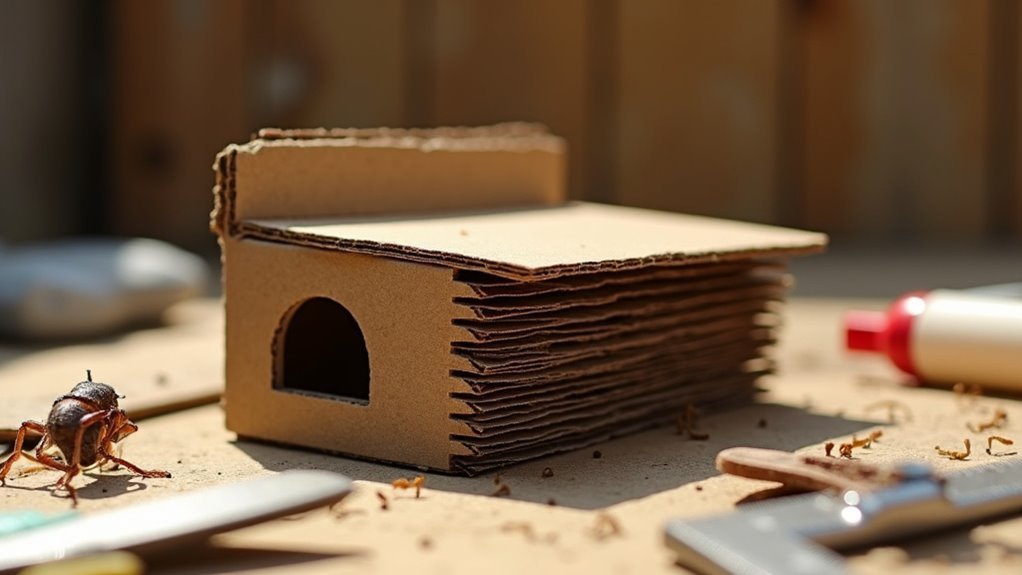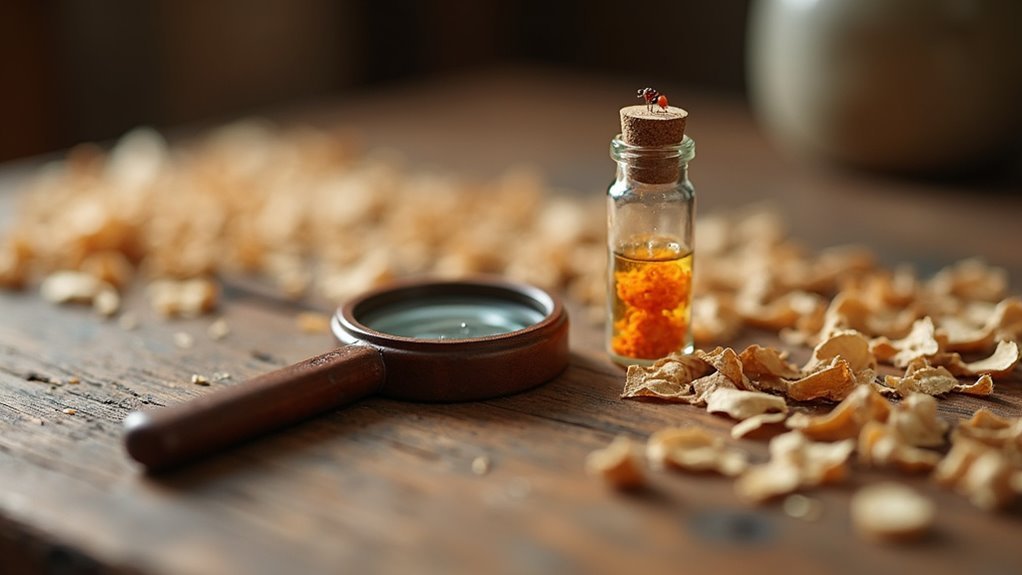You can create five effective homemade termite detectors using common materials: wet cardboard traps placed near your foundation to attract feeding termites, sound-based systems with microphones and amplifiers to capture tunneling noises, magnification tools with LED lights for detailed wood inspections, moisture-activated indicators using humidity sensors with alarms, and bait stations with slow-acting insecticides around your property’s perimeter. These DIY solutions help detect infestations months before visible damage appears, and mastering their construction will transform your termite monitoring capabilities.
Cardboard Trap Monitors for Early Detection

While expensive professional monitoring systems offer extensive protection, you can create effective termite detectors using simple cardboard materials from around your home.
Cardboard trap monitors work by wetting and stacking cardboard pieces, which attracts termites seeking food sources. Place these traps near your foundation in shaded areas for maximum effectiveness.
Check your traps every six months to a year during your termite inspection routine. Look for damage or frass indicating termite activity nearby.
If you discover termites in the traps, this signals an immediate need for getting rid of termites through professional control measures.
This cost-effective DIY method helps you catch a termite infestation early, potentially saving thousands in structural damage before problems escalate.
Sound-Based Detection Systems Using Microphones
Beyond visual inspection methods like cardboard traps, you can build sound-based detection systems that listen for termite activity within your walls.
These systems use microphones to capture feeding and tunneling sounds that subterranean termites produce while moving through wood structures. You’ll need a preamplifier to boost the microphone’s output signal – the LM386 amplifier works well for this purpose.
Microphones detect termite feeding sounds in wood while preamplifiers like the LM386 boost weak audio signals for better detection accuracy.
Filtering components are essential to eliminate background noise and focus on termite-specific frequencies. Your sound signals must be carefully calibrated to distinguish actual termite detection from environmental sounds like wind or household noise.
Through proper testing, these sound-based detection systems can effectively identify termite presence before visible damage occurs.
Visual Inspection Tools With Magnification

Since termite damage often begins with microscopic changes invisible to the naked eye, visual inspection tools with magnification become essential components of your homemade detection arsenal.
You’ll want a magnifying glass with at least 10x magnification to reveal intricate wood surface details and spot small holes that termites create. A jeweler’s loupe enhances your ability to examine wood fibers for tunneling damage during termite inspections.
Combine LED light sources with your magnification tools to illuminate hidden areas like basements, attics, and crawl spaces.
This powerful combination lets you thoroughly inspect wooden structures and beams for signs of termite activity including frass and entry points.
Regular use of these visual inspection tools enables early detection, potentially saving you thousands in costly repairs.
Moisture-Activated Indicator Devices
Because termites gravitate toward moisture-rich environments, you’ll find moisture-activated indicator devices particularly effective for early detection of conditions that attract these destructive pests.
Moisture-activated indicators excel at detecting humidity conditions that attract termites, providing crucial early warning before infestations take hold.
You can build these devices using basic moisture sensors that trigger alerts when humidity exceeds predetermined thresholds, signaling potential termite activity.
Enhance your system’s effectiveness by incorporating visual or audible alarms that immediately notify you of dangerous moisture levels.
Regular calibration of your moisture sensors guarantees accurate readings and reliable performance over time.
For thorough termite monitoring, combine these moisture-activated indicator devices with visual inspections and other detection methods.
This multi-layered approach considerably improves your ability to prevent termite infestations before they establish footholds in your property’s wooden structures.
Bait Station Monitoring Systems

While moisture detection helps identify favorable termite conditions, bait station monitoring systems take a more proactive approach by actually attracting and eliminating these pests at their source.
You’ll create stations containing slow-acting insecticides that foraging termites carry back to their colonies, effectively targeting entire populations.
Your bait stations require strategic placement around your property’s perimeter, considering these factors:
- Moisture levels and soil conditions that affect station effectiveness
- Easy access points for regular inspection every few months
- Visible bait compartments for monitoring termite activity
Unlike expensive pest control companies, you can build effective termite control solutions yourself.
These homemade bait stations function similarly to professional termite treatments, as they kill termites systematically while providing ongoing monitoring capabilities for thorough termite control around your property.
Frequently Asked Questions
Can I DIY Termite Bait Stations?
You can create DIY termite bait stations using cardboard or wood soaked in sugar-water. Place them in moist, shaded areas near suspected activity, checking regularly for feeding signs and replacing materials every few weeks.
Does Vinegar Really Kill Termites?
Yes, vinegar’s acetic acid kills termites on contact by damaging their exoskeletons and causing dehydration. You can mix it with lemon juice for increased potency, but it won’t eliminate severe infestations completely.
How to Make Homemade Termite Spray?
You’ll mix equal parts white vinegar and water in a spray bottle. Add two teaspoons of boric acid for enhanced effectiveness. Apply regularly in termite-prone areas to repel and kill termites naturally.
What Do Termites Hate the Most?
Termites hate neem oil most because it disrupts their hormonal balance. They’re also extremely repelled by clove oil’s eugenol, orange oil’s d-limonene, boric acid’s toxicity, and salt’s dehydrating effects.
In Summary
You’ve now got five effective DIY methods to catch termite activity before it becomes a costly problem. These homemade detectors won’t replace professional inspections, but they’ll give you an early warning system that could save thousands in damage. Set up multiple detection types around your property’s vulnerable areas, and check them regularly. Remember, early detection is your best defense against these destructive pests taking over your home.





Leave a Reply